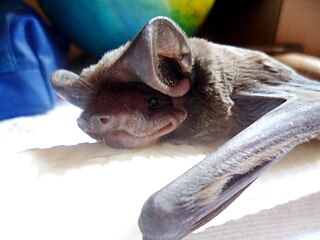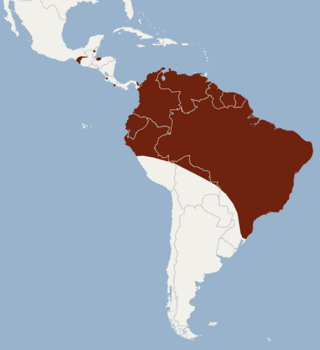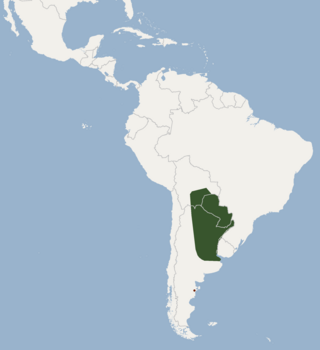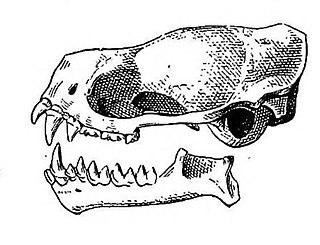
The velvety myotis, is a species of vesper bat from South America.

The dwarf bonneted bat, or Peters' mastiff bat,, is a bat species from South and Central America.

Wagner's bonneted bat or Wagner's mastiff bat, is a species of bat in the family Molossidae. It is found in the Americas from Argentina and Peru north to Mexico, and Cuba. Populations in Florida in the United States are now recognized as the Florida bonneted bat

Sanborn's bonneted bat, is a bat species from South and Central America. It was first described from a specimen collected at Colonia Hansa, Brazil, and is sometimes also known as the Hansa bonneted bat.

The tailed tailless bat is a species of leaf-nosed bat from South America.

The dark fruit-eating bat, is a bat species from South America.

The dark long-tongued bat is a species of bat from South and Central America. It was formerly considered the only species within the genus Lichonycteris, but is now recognized as one of two species in that genus, along with the pale brown long-nosed bat. It is small species of bat, with adults weighing 6–11 g (0.21–0.39 oz) and having a total length of 46–63 mm (1.8–2.5 in).

The dwarf little fruit bat is a species of leaf-nosed bat from South America.

The visored bat,, is a bat species from tropical South America. It is the only species in the genus Sphaeronycteris. Although visored bats have some unique characteristics, they are thought to be most closely related to little white-shouldered bats and wrinkle-faced bats.

Eumops is a genus of bats in the family Molossidae. A total of 17 species of this genus have been described. The name "Eumops" comes from the Greek prefix "Eu-", meaning "good" or "true," and the Malayan word "mops," which means bat.

The western mastiff bat, also known as the western bonneted bat, the greater mastiff bat, or the greater bonneted bat, is a member of the free-tailed bat family, Molossidae. It is found in the Western United States, Mexico and South America. This species is the largest bat native to North America, and some of its distinguishing characteristics are its large ears, wings, and forearms. The subspecies Eumops perotis californicus is a species of concern as identified by the U.S. Fish and Wildlife Service. The range of this subspecies is principally southwest desert regions of the United States, along the border with Mexico; however, the range extends as far north on the Pacific coast as Alameda County, California.

The lesser bamboo bat or lesser flat-headed bat is one of the smallest species of vesper bat, and is native to Southeast Asia.

The hairy-legged myotis is a species of mouse-eared bat. It is found from southern Tamaulipas in Mexico, through much of Central America and across northern South America as far east as Trinidad. Further south, it is found along the foothills of the Andes as far south as northern Argentina.

The big bonneted bat, or Dabbene's mastiff bat is a species of bat in the family Molossidae, native to South America. It is named for a former conservator at the Buenos Aires National Museum.

The Guianan bonneted bat, or Thomas's mastiff bat, is a species of free-tailed bat from South America. It is poorly understood, because it is difficult to capture, and may be one of the rarest Neotropical bats.

The Cuban fig-eating bat, or white-shouldered bat, is a species of bat in the family Phyllostomidae, found only in the Caribbean. It is the sole extant species in the genus Phyllops, although two other species, P. vetus and P. silvai, are known from fossils.

The Patagonian bonneted bat, also called the Patagonian dwarf bonneted bat, is a species of free-tailed bat found in Argentina, Bolivia and Paraguay.

The southern big-eared brown bat is a species of bat from the family Vespertilionidae. Although current taxonomy treats the southern big-eared brown bat as a separate species, it is often treated as a subspecies of the small big-eared brown bat. It lives in the forests of southern Argentina and Chile; though the population of the bat in the southern part of its habitat is low, there are no major concerns to justify anything lower than a Least Concern rating in the IUCN Red List.

Eumops nanus is a species of bat found in Central and South America.

Eumops ferox, the fierce bonneted bat or the chestnut mastiff bat, is a species of free-tailed bat found in the Caribbean and Mexico. Until recently, it was synonymous with Wagner's bonneted bat.






















